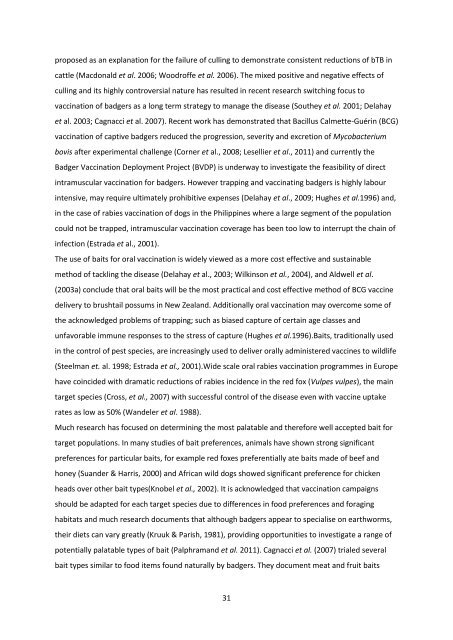Developing an oral bait for badger vaccination - Exeter Research ...
Developing an oral bait for badger vaccination - Exeter Research ...
Developing an oral bait for badger vaccination - Exeter Research ...
You also want an ePaper? Increase the reach of your titles
YUMPU automatically turns print PDFs into web optimized ePapers that Google loves.
proposed as <strong>an</strong> expl<strong>an</strong>ation <strong>for</strong> the failure of culling to demonstrate consistent reductions of bTB in<br />
cattle (Macdonald et al. 2006; Woodroffe et al. 2006). The mixed positive <strong>an</strong>d negative effects of<br />
culling <strong>an</strong>d its highly controversial nature has resulted in recent research switching focus to<br />
<strong>vaccination</strong> of <strong>badger</strong>s as a long term strategy to m<strong>an</strong>age the disease (Southey et al. 2001; Delahay<br />
et al. 2003; Cagnacci et al. 2007). Recent work has demonstrated that Bacillus Calmette-Guérin (BCG)<br />
<strong>vaccination</strong> of captive <strong>badger</strong>s reduced the progression, severity <strong>an</strong>d excretion of Mycobacterium<br />
bovis after experimental challenge (Corner et al., 2008; Lesellier et al., 2011) <strong>an</strong>d currently the<br />
Badger Vaccination Deployment Project (BVDP) is underway to investigate the feasibility of direct<br />
intramuscular <strong>vaccination</strong> <strong>for</strong> <strong>badger</strong>s. However trapping <strong>an</strong>d vaccinating <strong>badger</strong>s is highly labour<br />
intensive, may require ultimately prohibitive expenses (Delahay et al., 2009; Hughes et al.1996) <strong>an</strong>d,<br />
in the case of rabies <strong>vaccination</strong> of dogs in the Philippines where a large segment of the population<br />
could not be trapped, intramuscular <strong>vaccination</strong> coverage has been too low to interrupt the chain of<br />
infection (Estrada et al., 2001).<br />
The use of <strong>bait</strong>s <strong>for</strong> <strong>oral</strong> <strong>vaccination</strong> is widely viewed as a more cost effective <strong>an</strong>d sustainable<br />
method of tackling the disease (Delahay et al., 2003; Wilkinson et al., 2004), <strong>an</strong>d Aldwell et al.<br />
(2003a) conclude that <strong>oral</strong> <strong>bait</strong>s will be the most practical <strong>an</strong>d cost effective method of BCG vaccine<br />
delivery to brushtail possums in New Zeal<strong>an</strong>d. Additionally <strong>oral</strong> <strong>vaccination</strong> may overcome some of<br />
the acknowledged problems of trapping; such as biased capture of certain age classes <strong>an</strong>d<br />
unfavorable immune responses to the stress of capture (Hughes et al.1996).Baits, traditionally used<br />
in the control of pest species, are increasingly used to deliver <strong>oral</strong>ly administered vaccines to wildlife<br />
(Steelm<strong>an</strong> et. al. 1998; Estrada et al., 2001).Wide scale <strong>oral</strong> rabies <strong>vaccination</strong> programmes in Europe<br />
have coincided with dramatic reductions of rabies incidence in the red fox (Vulpes vulpes), the main<br />
target species (Cross, et al., 2007) with successful control of the disease even with vaccine uptake<br />
rates as low as 50% (W<strong>an</strong>deler et al. 1988).<br />
Much research has focused on determining the most palatable <strong>an</strong>d there<strong>for</strong>e well accepted <strong>bait</strong> <strong>for</strong><br />
target populations. In m<strong>an</strong>y studies of <strong>bait</strong> preferences, <strong>an</strong>imals have shown strong signific<strong>an</strong>t<br />
preferences <strong>for</strong> particular <strong>bait</strong>s, <strong>for</strong> example red foxes preferentially ate <strong>bait</strong>s made of beef <strong>an</strong>d<br />
honey (Su<strong>an</strong>der & Harris, 2000) <strong>an</strong>d Afric<strong>an</strong> wild dogs showed signific<strong>an</strong>t preference <strong>for</strong> chicken<br />
heads over other <strong>bait</strong> types(Knobel et al., 2002). It is acknowledged that <strong>vaccination</strong> campaigns<br />
should be adapted <strong>for</strong> each target species due to differences in food preferences <strong>an</strong>d <strong>for</strong>aging<br />
habitats <strong>an</strong>d much research documents that although <strong>badger</strong>s appear to specialise on earthworms,<br />
their diets c<strong>an</strong> vary greatly (Kruuk & Parish, 1981), providing opportunities to investigate a r<strong>an</strong>ge of<br />
potentially palatable types of <strong>bait</strong> (Palphram<strong>an</strong>d et al. 2011). Cagnacci et al. (2007) trialed several<br />
<strong>bait</strong> types similar to food items found naturally by <strong>badger</strong>s. They document meat <strong>an</strong>d fruit <strong>bait</strong>s<br />
31
















